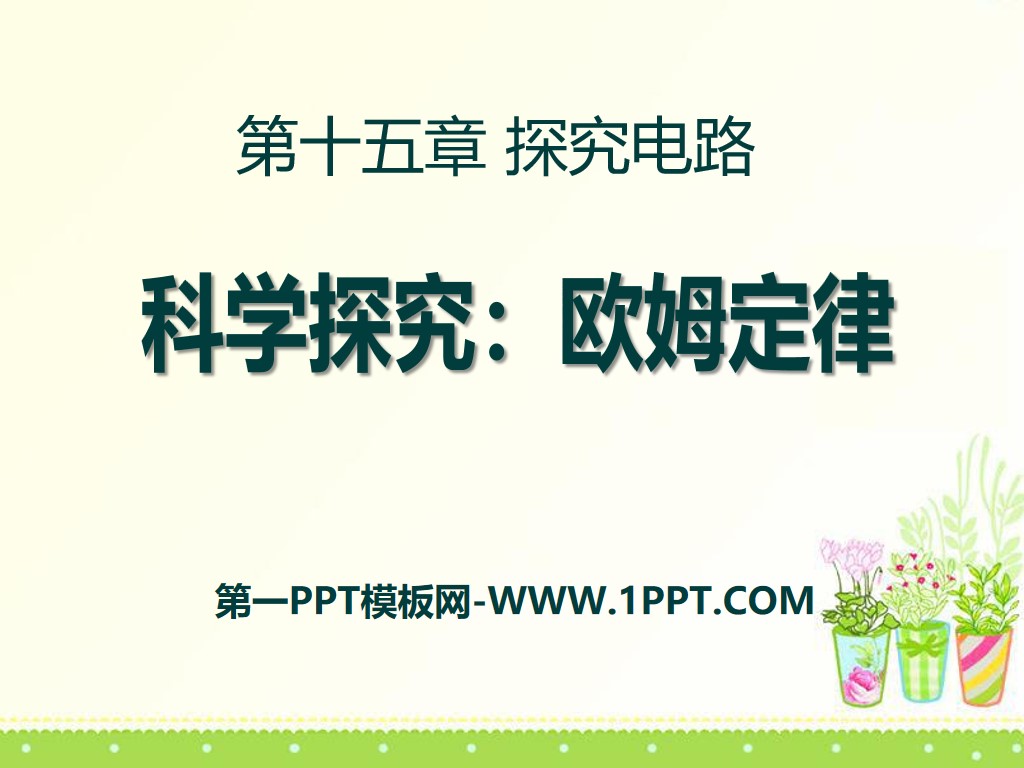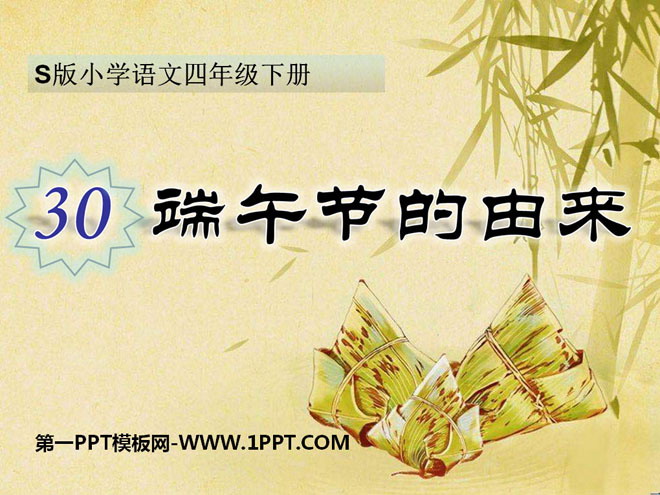
| Category | Format | Size |
|---|---|---|
| Shanghai Science Edition Ninth Grade Physics | pptx | 6 MB |
Description
"Scientific Exploration: Ohm's Law" Exploring Circuit PPT Courseware 3
Review What did we learn in the last lesson?
1. Resistance
2. Factors affecting resistance
1. Cross-sectional area of conductor
2. The length of the conductor
3. Conductor material
4: What role does the sliding rheostat play in the circuit?
What factors are related to the size of the current?
think about it
People use electricity mainly to utilize various effects of electric current, such as thermal effect, magnetic effect, chemical effect, etc. of electric current. These effects are all related to the size of the current. So, what factors are related to the size of the current?
Knowledge preparation
Previously we learned:
1. Voltage is the cause of current
2. Resistance is the resistance of a conductor to current flow
Questions about the relationship between current, voltage, and resistance are what we will learn in this lesson.
Ask questions and make assumptions
1. Since voltage is the cause of current, will the current also increase when the voltage is increased?
2. Since resistance hinders current, will the current through the conductor decrease as the resistance increases?
Plan and design experiments
Experimental idea: Measure the physical quantity data of U, I, and R regularly and find the rules.
Usage: Control variable method
To study the relationship between three quantities, we often use the control variable method: leaving one quantity unchanged and observing the relationship between the other two quantities.
hint:
1. We have multiple fixed-value resistors, which can control the resistance constant and observe the changing relationship between current and voltage.
2. Knowing the resistance, what instruments can be used to measure current and voltage?
3. How can we easily measure multiple sets of data?
conduct experiment:
1. Design experimental circuit diagram and select experimental equipment
2. Connect the physical diagram according to the circuit diagram
Notice:
1. Disconnect the switch before connecting the circuit
2. Move the sliding varistor slider to the maximum resistance position
3. Select the appropriate range and correct terminals for the ammeter and voltmeter.
From the analysis of the data and curve graph in Table 1, it can be seen that
Through the experiment just now, we found that the current in the conductor is related to the voltage across the conductor
When the resistance is constant, the higher the voltage across the conductor, the greater the current through the conductor.
That is: the current through a conductor is proportional to the voltage across the conductor
Note that (1) the current in the conductor and the voltage at both ends of the conductor here refer to the same period of time for the same section of conductor; (2) it cannot be said the other way around. When the resistance is constant, the voltage is proportional to the current. There is a logical relationship here. , here voltage is the cause and current is the result. It is because voltage is added to both ends of the conductor that there is current in the conductor.
From the analysis of the data and curve graph in Table 2, it can be seen that
Through the experiment just now, we found that the current in the conductor is related to the resistance of the conductor
When the voltage is constant, the greater the resistance of the conductor, the smaller the current passing through the conductor. It can be seen from the curve
The current through a conductor is inversely proportional to the resistance of the conductor.
Note: It cannot be said that the resistance of a conductor is inversely proportional to the current flowing through it. We know that resistance is a characteristic of the conductor itself. Even if the conductor does not carry current, its resistance will not change, let alone due to the increase in current in the conductor. Increase or decrease causing its resistance to change.
Understanding Ohm’s Law:
1. Ohm's law reflects the quantitative relationship between current, voltage and resistance in a conductor (that is, voltage, current, and resistance are identical and simultaneous for the same conductor at the same time)
2. In a circuit, if we know any two of the three physical quantities I, U, and R, we can use Ohm's law to find the other quantity.
3. When applying Ohm’s Law calculations, please note that the unit is the International System of Units.
4. "The current in a conductor is proportional to the voltage at both ends of the conductor and inversely proportional to the resistance of the conductor" is proportional to the premise that "the resistance of the conductor is certain and the voltage is certain." Without the premise, this proportional relationship does not exist.
Small scale chopper
1. When the voltage across a resistor is 3V, the current flowing through it is 0.3A. When the voltage increases to 6V, its current is _____; if the current is to be 0.1A, then the voltage is ___.
2. When the power supply voltage remains unchanged, the current passing through is 0.6A when a 5Ω resistor is connected. Then change the resistor to 15Ω, and the current passing through is ___
Communication Assessment:
1. What is the difference between the conclusion of the analysis experiment and the initial hypothesis?
2. Analyze the causes of experimental errors and explore measures to improve experiments
3. What quantitative relationship did you find between the current, voltage, and resistance of the same resistor? How to express? How would you express the above two conclusions in one sentence?
Class summary:
Let the students summarize the content of this section together. In this lesson we learned
(1) Use an ammeter and voltmeter to measure the voltage across a section of conductor and the current flowing through the conductor.
(2) Through experiments, the relationship between the current flowing through the conductor, the voltage across the conductor and the resistance of the conductor itself was explored: the current in the conductor is directly proportional to the voltage across the conductor and inversely proportional to the resistance of the conductor.
Feedback during class:
1. To study the relationship between current, resistance and voltage, use the circuit shown on the right. During the experiment, keep the resistance constant and keep the voltage constant. In the step of keeping the resistance constant, the experimental requirements are: ( )
A. Keep the position of the sliding blade of the sliding rheostat R’ unchanged.
B. Keep the voltage across the resistor box R unchanged
C. Keep the fixed resistance value unchanged and adjust the slider of R’ to different appropriate positions.
D. Keep the current in the circuit constant.
2. In the experiment above, in the step of keeping the voltage constant, the experimental requirements ( )
A. Use a power supply with a different voltage and adjust the slider of R’ to keep the voltage on R unchanged.
B. Change the size of resistor R, adjust the slider of R’, and keep the voltage across R unchanged.
C. Adjust the slider of R’ to the appropriate position so that the voltage across R remains unchanged.
D. Adjust the slider of R’ to the appropriate position so that the voltage across R’ remains unchanged.
Consolidate and sublimate:
1. When a student was doing an experiment to study the relationship between current, voltage, and resistance, he obtained the following two sets of data:
1) Analyzing the data in the table on the left, it can be concluded that when the resistance is constant, the current in the conductor is proportional to the voltage at both ends of the conductor.
2) Analyzing the data in the table on the right, it can be concluded that when the voltage remains unchanged, the current in the conductor is inversely proportional to the resistance of the conductor.
3) Based on the above conclusions, it can be concluded that the current in a conductor is directly proportional to the voltage across the conductor and inversely proportional to the resistance of the conductor.
2. When a voltage of 2 V is applied to both ends of a conductor, the current flowing through is 0.5 A. If the voltage at both ends of the conductor increases to 10 V, then ( )
A. Both the resistance of the conductor and the current passing through the conductor increase.
B. The resistance of the conductor and the current passing through the conductor become smaller.
C. The resistance of the conductor and the current passing through the conductor remain unchanged.
D. The resistance of the conductor remains unchanged and the current through the conductor increases.
3. While keeping the circuit voltage constant, when the resistance of the circuit increases to 2 times its original value, the current through the circuit ______ to its original ______.
4. In the experiment to study the relationship between current, voltage and resistance, the following data were obtained. Please fill in the data in the blank spaces in the table based on the conclusions obtained from the experiment.
Keywords: Exploring Circuit Teaching Courseware, Scientific Exploring Ohm’s Law Teaching Courseware, Shanghai Science Edition 9th Grade Physics PPT Courseware Download, 9th Grade Physics Slide Courseware Download, Exploring Circuit PPT Courseware Download, Scientific Exploring Ohm’s Law PPT Courseware Download,. PPT format;
For more information about the "Exploring Circuits Scientifically Exploring Ohm's Law" PPT courseware, please click the Exploring Circuits ppt Scientifically Exploring Ohm's Law ppt tag.
"Scientific Exploration: Ohm's Law" Exploring Circuit PPT Courseware 4:
"Scientific Exploration: Ohm's Law" Exploring Circuit PPT Courseware 4 Knowledge Preparation You must still remember: 1. Voltage is the cause of _______. 2. Resistance represents the resistance of a conductor to ________. Question: So the current flowing through a conductor is related to the...
"Scientific Exploration: Ohm's Law" Exploring Circuit PPT Courseware 2:
"Scientific Exploration: Ohm's Law" Exploration Circuit PPT Courseware 2 Ohm's Law and its Application 1. Content: The current in a conductor is _____ to the voltage across the conductor and _____ to the resistance of the conductor. 2. Formula: I=U/R The meaning and unit of each letter in the formula are: U voltage _____( ..
"Scientific Exploration: Ohm's Law" Exploring Circuit PPT Courseware:
"Scientific Exploration: Ohm's Law" Exploring Circuit PPT Courseware Exploring the Relationship between Current, Voltage, and Resistance 1. Exploration plan: (1) Control _____ unchanged to explore the relationship between current and voltage; (2) Control _____ unchanged to explore The relationship between current and resistance. 2. Explore the conclusion: (1) Keep...
File Info
Update Time: 2024-08-06
This template belongs to Physics courseware Shanghai Science Edition Ninth Grade Physics industry PPT template
"Scientific Exploration: Ohm's Law" Exploring Circuit PPT Courseware 3 Simple campus recruitment activity planning plan summary enterprise and institution recruitment publicity lecture PPT template is a general PPT template for business post competition provided by the manuscript PPT, simple campus recruitment activity planning plan summary enterprise and institution recruitment promotion Lecture PPT template, you can edit and modify the text and pictures in the source file by downloading the source file. If you want more exquisite business PPT templates, you can come to grid resource. Doug resource PPT, massive PPT template slide material download, we only make high-quality PPT templates!
Tips: If you open the template and feel that it is not suitable for all your needs, you can search for related content "Scientific Exploration: Ohm's Law" Exploring Circuit PPT Courseware 3 is enough.
How to use the Windows system template
Directly decompress the file and use it with office or wps
How to use the Mac system template
Directly decompress the file and use it Office or wps can be used
Related reading
For more detailed PPT-related tutorials and font tutorials, you can view: Click to see
How to create a high-quality technological sense PPT? 4 ways to share the bottom of the box
Notice
Do not download in WeChat, Zhihu, QQ, built-in browsers, please use mobile browsers to download! If you are a mobile phone user, please download it on your computer!
1. The manuscript PPT is only for study and reference, please delete it 24 hours after downloading.
2. If the resource involves your legitimate rights and interests, delete it immediately.
3. Contact information: service@daogebangong.com
"Scientific Exploration: Ohm's Law" Exploring Circuit PPT Courseware 3, due to usage restrictions, it is only for personal study and reference use. For commercial use, please go to the relevant official website for authorization.
(Personal non-commercial use refers to the use of this font to complete the display of personal works, including but not limited to the design of personal papers, resumes, etc.)
Preview





















